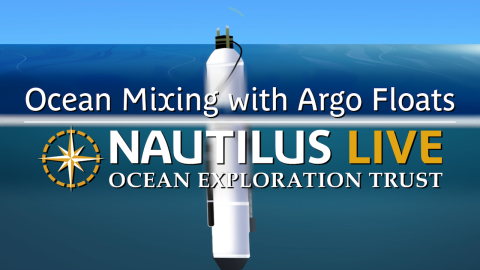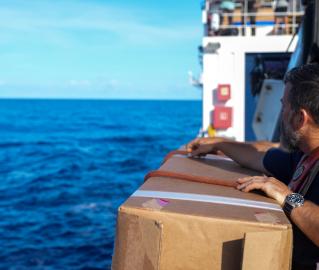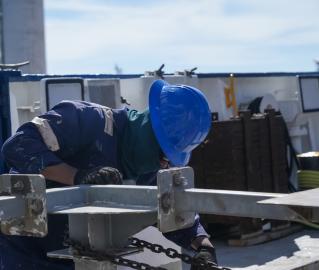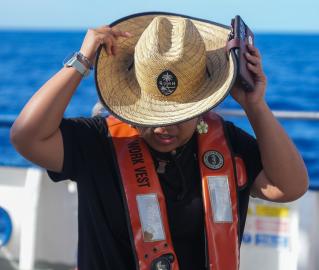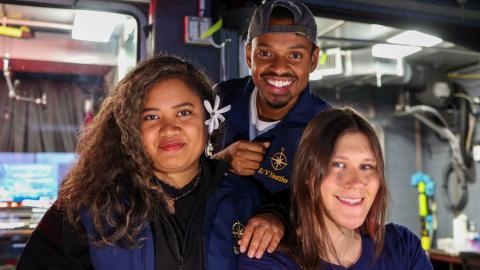Carrying Stories into the Sea: Tracking Argo Floats and Student Science
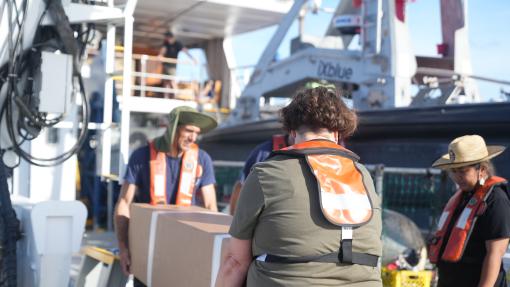
This blog was written by NA172 Lead Science Communication Fellow Emily Jones.
As the last rays of sunlight slipped beneath the Pacific horizon, I stood on the stern deck watching Guest Scientist Melissa Miller, Deck Chief Thomas Scanlon, and DriX team member Basile Rose carry the first Argo float into position. Nearby, Science Communication Fellow Shelterihna Alokoa waved farewell to the narrow cardboard box as it was gently lowered into the waters of the Western Pacific Ocean, just off the islands of the Federated States of Micronesia.
During this mapping transit, I have had the joy of documenting the work that Miller is leading for Scripps Institution of Oceanography as part of the Global Ocean - Biogeochemistry Array (GO-BGC) and SOCCOM programs. During Nautilus’ seven-day mapping expedition from Guam to the Solomon Islands, the Science Communication Fellows captured Melissa’s successful deployment of six biogeochemical Argo floats. These instruments have now joined a global network of over 4,000 floats dedicated to monitoring ocean health in real time.
Melissa tells me that this work “fills her cup” because of her deep love for data. With a gentle smile, she gazes at the Solomon Islands on the horizon. and says, “All data is good data. The more we know about these parameters, the more we can track the changes taking place in our oceans.”
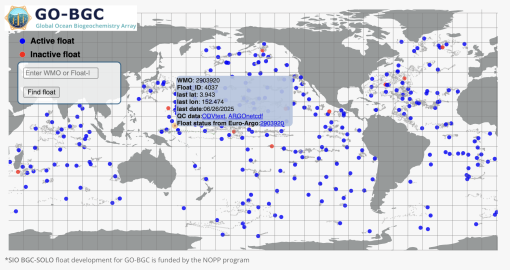
Map of GO-BGC biogeochemical Argo floats. Float 4037, deployed during this expedition, is highlighted in orange near the Solomon Islands.
In order from top left to bottom right, the adopted float numbers and names 0026 - Ethan Allen, 4036 - Green Mountain, 4037 - Thingamajig 3, 4038 - RHINO 2.0, 4022 - Fish Knuckles, 4035 - Oligo2
She’s right. As an educator and science communicator, I also love data—and I’m genuinely excited by the ability to openly access what Argo floats report after each 10-day cycle of sinking, sensing, and sending. With my learners, I’ve seen firsthand how powerful this type of data can be in the classroom, especially for teachers looking to ground abstract scientific concepts in real-world phenomena.
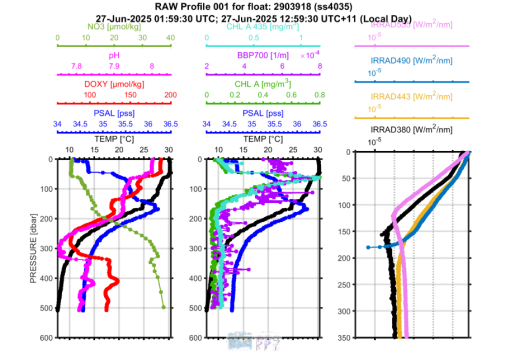
First set of data reported back from Oligo 2.
The first reading back from Oligo2 informs us that the float reached a depth of 510 meters within the first 24 hours. Measuring a relative surface nitrate level of 5μmol/kg, potential hydrogen of around 8.2, salinity of 34 pps, and various chlorophyll readings that all follow a similar pattern throughout the water column.
While Argo data presents a clear opportunity to strengthen math literacy and support the teaching of core scientific principles, it offers something even more profound: a chance for students to see themselves as part of a global scientific community—one that is actively observing, questioning, and caring for our planet.
I was so excited to learn about the Adopt-a-Float program and the ways it creates personal connections with students. “Classrooms all around the world can adopt these floats, name them, and monitor the data that they ping back to us,” Melissa shares with the science team during her evening talk.
Each of the six Argo floats that Melissa and the team deployed during our transit has been named by the classrooms that adopted them. For the high schoolers at Sydney Distance Education, Oligo2 marked their second adopted float.
The impact of the Adopt-a-Float Program lies in the sense of agency it gives students, connecting them directly to global science and allowing them to see their role in understanding and protecting our oceans.
“We named it Oligo, after the Oligocene Epoch,” their teacher shared with Melissa and I during a Ship-to-Shore call. “Oligo 2 is our second float, since our first one stopped reporting after a few years,” added one student.
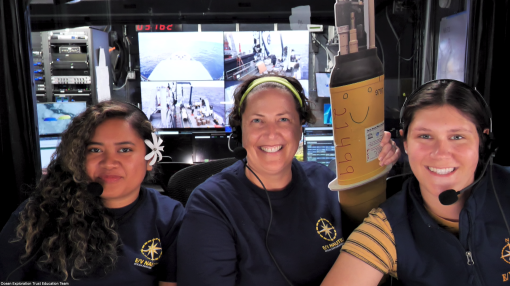
Ship-to-shore image of Emily K. Jones, Shelterihna Alokoa, and Melissa Miller during their Ship-to-shore call.
Around 25 million years ago, during the Oligocene epoch, Earth transitioned from a warm, greenhouse gas-driven climate—similar to today’s conditions—into the cooler Eocene period, marked by the formation of polar ice sheets and global cooling. Today, as we face another critical climate shift, the data collected by Argo floats plays a vital role in monitoring patterns in ocean temperature, pH, dissolved oxygen, and nitrate (NO₃) levels. These instruments help scientists track how Earth’s systems are responding to modern climate change and reveal the interconnectedness of physical, chemical, and biological processes in the ocean.
“Regarding Oligocene life, Ankylorhiza is a pretty cool whale—it was our class’s pick when we named the first Oligo float,” shared educator Emily Fewster of Sydney Distance Education.
Before deploying Oligo 2, Science Communication Fellow Shelterihna Alokoa and Melissa took a moment to honor the ancient era by sketching the extinct seabird Pelagornis and extinct toothed whale Ankylorhiza on the float’s deployment box. Sheltherhina also wrote greetings and blessings in Pohnpeian, Kosraean, Yapese, and Chuukese—the languages of her ancestors in the waters for which the floats were deployed on our transit. Words shared by the people connected through the waters of the Federated States of Micronesia. These words serve as both welcome and witness, carried out to sea with the float to honor the enduring connection between ocean, culture, and science.
Small acts like these celebrate the connection between stewardship, science, and the stories we carry into the sea. They also demonstrate the agency we have as humans and caretakers of our shared oceans and lands.
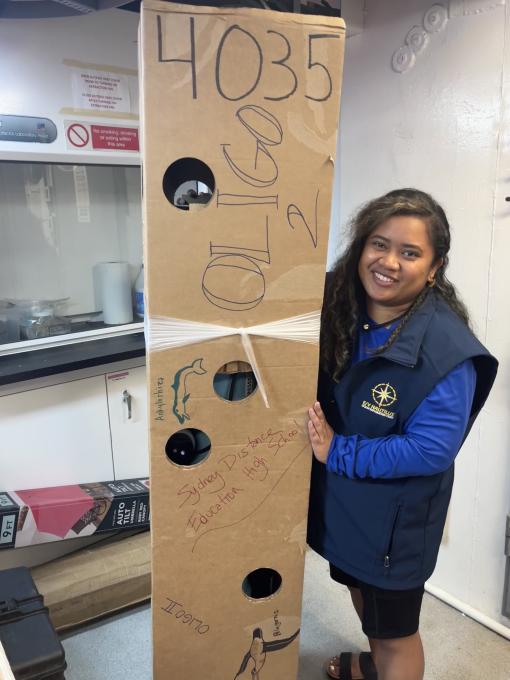
Shell with Oligo 2.
In my work with youth and Pacific salmon populations, I’m often asked about the resilience of these species. In the face of warming tributaries and changing ecosystems, students ask me almost daily, “What can we do to help our waters?”
While I’m still forming my own answers to that question, one thing I know for certain is that the root of any meaningful response is agency. As social beings, we evolved to contribute—our collective wellbeing has always depended on our ability to listen deeply, in order to shape our world through careful action.
The Adopt-a-Float program is one powerful way educators can support youth in reclaiming that agency. It invites students to take part in real-world science, fostering curiosity, stewardship, and a deeper understanding of the data that tells the story about our planet.
25 hours after it spashed, we received the first data profile for Sydney Distance’s Oligo2, painting a picture of the waters around the Federated States of Micronesia. We can also see temperature (TEMP) decreasing steadily with depth, from about 29°C at the surface to below 10°C at 510 meters. Chlorophyll-a (CHL A) and backscatter (BBP700) readings show a concentration peak in the upper 100 meters, suggesting a layer of biological productivity near the surface, likely related to phytoplankton presence.
These patterns—especially in chlorophyll fluorescence and light levels —give us a glimpse into the vertical structure of the water column and help track how light, temperature, and nutrients vary with depth. This is just the beginning of Oligo 2’s contributions to a global dataset that helps student scientists understand and respond to changes in ocean chemistry and biology.
With six successful deployments now complete and data slowly rolling in, I feel deep gratitude for the many ways humans listen, learn, and take action to care for the shared waters around us. I encourage you to follow the journey of these six Argo floats and explore the data they’re collecting—you can track their locations and updates here by searching for each float using the Float IDs below: Global Ocean - Biogeochemistry Array
Melissa has shared specifics about Argo floats and how she deployed in her blog here.
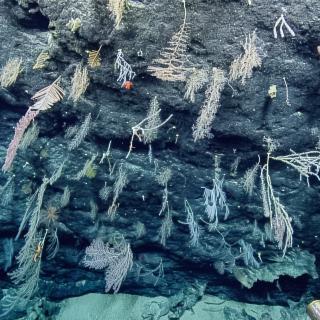
Exploring the Offshore Marianas
Update: Ongoing mechanical repair of a ship system has changed operational plans for the NA172 expedition, postponing the water column exploration and remotely operated vehicles portion of this expedition within the Mariana Trench Marine National Monument.
